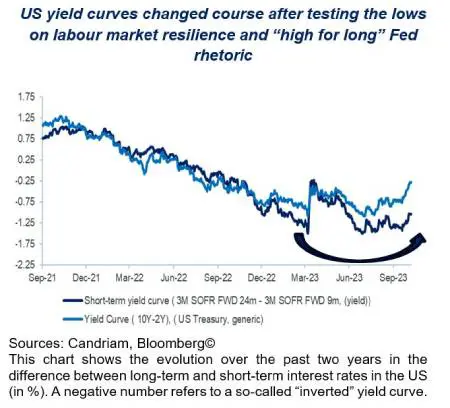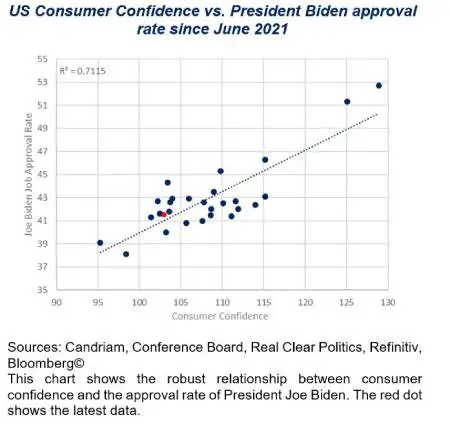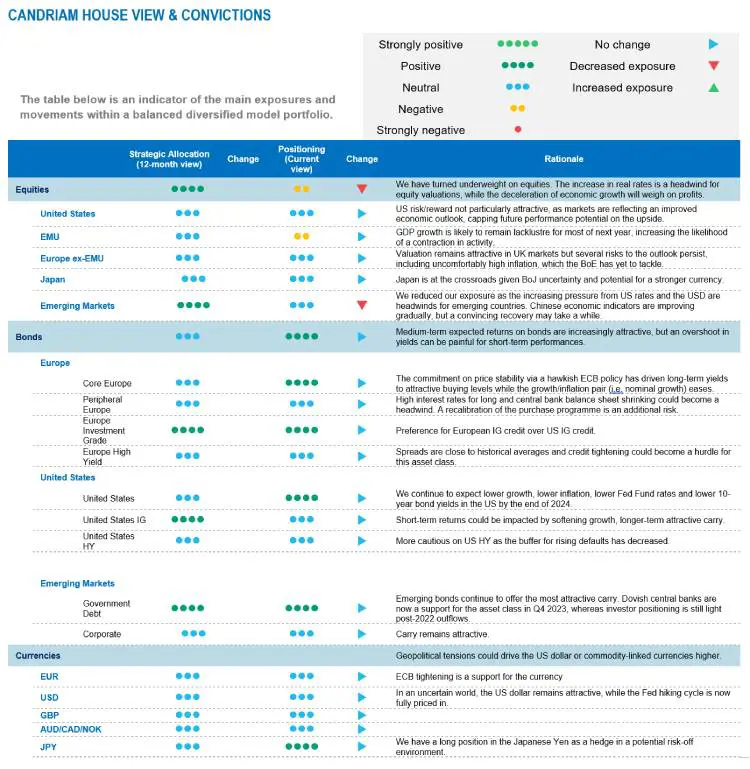Our asset allocation has turned more cautious as several risks have started to materialise. Central banks on both sides of the Atlantic maintain a restrictive monetary policy, implying that sluggish economic growth in 2024 is the most likely outcome. In addition, the sharp rise in bond yields over the summer months – the US 10-year yield rose 73 bps during Q3 – tightens financial conditions further, raising pressure on the economy and on risk assets. Globally, the increase in real rates is a headwind for equity valuations, while the deceleration of economic growth will weigh on profits, leading us to adopt an underweight positioning on equities. Risks to the outlook for global growth remain tilted to the downside as geopolitical developments unfold: several war fronts are open, implying rising uncertainty and vulnerabilities.
A restrictive monetary policy
The persistent hawkish bias among central banks in developed markets and the resilience in both inflation and labour markets have led to an upward repricing in bond yields. With policy rates high for longer than markets had hoped for, the credit channel is getting ever more restrictive via tighter bank lending conditions.
We note these evolutions: in our main scenario, we continue to expect the US to avoid a recession, but if long-term rates remain at the level reached in early October for the coming months, a downturn next year would become more likely.
In Europe, PMI indices stabilised at a low level in September, pointing to a moderate contraction in activity. As growth is likely to remain lacklustre for most of next year, the likelihood of a recession is increasing in the region. Clearly, while the disinflation trend is broadly continuing as expected – in the eurozone, a sub-3% handle in Q1 2024 is possible – the ECB has no choice but to accept the risk of this contraction in activity.
In China, economic activity and the evolution of prices have shown some timid signs of cyclical stabilisation. Economic indicators are improving gradually but lack a convincing recovery to restore confidence in this market.
The markets’ response of higher long-term bond yields indicates a shift from recent trends: the yield curves do not invert further anymore as investors re-asses upward the premium for holding long-term yields.

Timing of the last Fed hike is key
We have been looking for historical references of previous tightening cycles to gain a perspective on the current episode. Over the past half century, 10-year yields have tended to hit their peak once the Fed stops hiking. This holds true whatever the length of the cycle. Interestingly, within the six months after the last Fed hike, the 10-year bond yield has always fallen below the level reached at the peak. Identifying the peak in the Federal funds level is therefore an important input to further increase duration.
Furthermore, we make the following observations:
- On average, the Fed cuts its rates six months after its last hike while a recession starts seven months after its last hike in the Funds rate. In other words, the first cut takes place one month before a recession starts.
- However, every cycle is different. Not every rate hike cycle has led to a recession. In 1984, 1995 and 1997, monetary tightening was not followed by recessions. But we note that in these years, the yield curve did not invert.
- Regarding the median evolution of US equity markets, the peak is reached two months ahead of the last hike reaching the terminal rate.
- Finally, the median observation of the market trough is reached six months after the last hike. Empirical evidence shows that the beginning of a new equity bull market coincides with the Fed pivot and the start of a new easing cycle.
Geopolitical uncertainties
The opening of a new front in the Middle East in addition to the ongoing war in Ukraine implies rising uncertainty and vulnerabilities.
While it is too early to understand the full impact of the intensification of the conflict between Israel and Hamas, we would monitor the risk of further escalation on oil supply via two important petroleum-exporting countries:
- a reduced probability of Saudi-Israeli diplomatic normalisation and its associated boost to Saudi production;
- risks to Iranian oil production are now tilted to the downside.
In less than one year, mail-in ballots and early voting for the US elections of 5 November 2024 will have started. As of today, President Joe Biden and his predecessor Donald Trump seem the most likely candidates to be nominated by the Democratic and Republican conventions next summer. At the current juncture of course, it makes little sense to start speculating about the outcome.
However, we know from previous campaigns that the approval rate of the President is a good proxy to gauge the chances of the incumbent in the upcoming elections. In turn, the approval rate shows a robust correlation with the evolution of consumer confidence. Investors will be well advised to continue following that indicator closely in the coming months.

A more cautious asset allocation
To conclude, the following reasons motivate our more cautious asset allocation via a downgrade of our equity stance from neutral to underweight:
- an ongoing restrictive monetary policy,
- a bear steepening of the yield curve via higher long-term yields,
- a tightening in financial and credit conditions,
- an expected deceleration of economic growth, which will weigh on corporate profits and
- a rise in geopolitical risks, potentially leading to a further increase in oil prices.
Within our regional equity allocation, we reduced our exposure on Emerging markets from overweight to neutral as the increasing pressure from US rates and the USD are significant headwinds for emerging countries. Hence, we are currently underweight on eurozone equities and neutral on other regions.
Following negative months registered in August and September, market sentiment is less stretched, but we think it is too early to buy back equities and keep a preference for more defensive sectors at this stage of the economic cycle.
Another risk mitigation limiting the downside could be central bank communications or actions towards a pivot. Yet we think that it is too early as data releases are not deteriorating sharply.
In this context, we prefer government bonds and high-quality credit as sources of carry and have chosen to remain exposed to emerging countries debt to benefit from the most attractive carry and the desynchronisation of their monetary and fiscal cycles.

